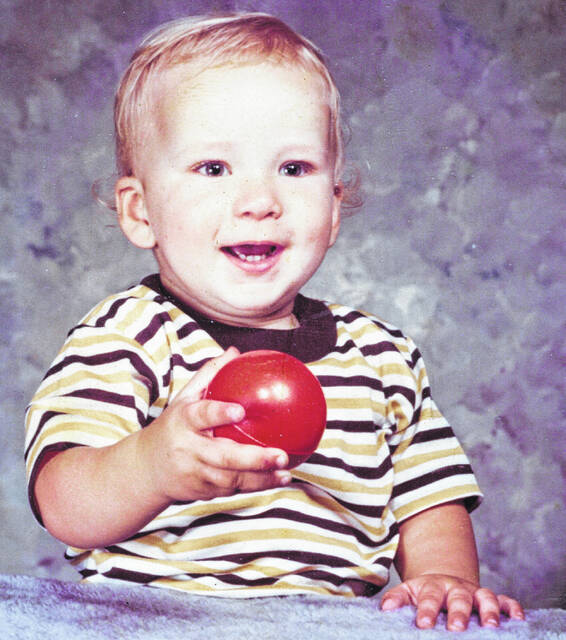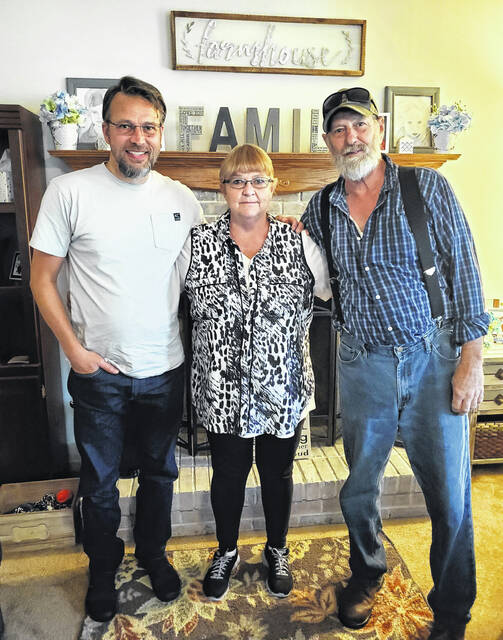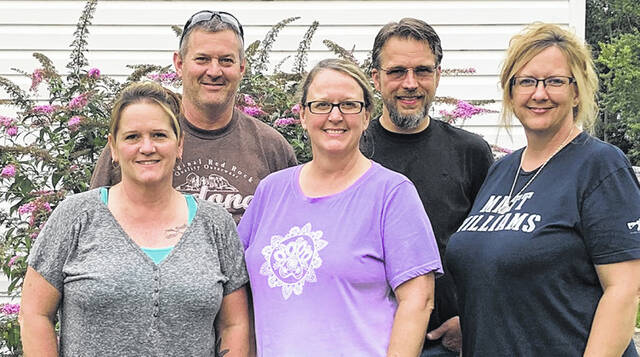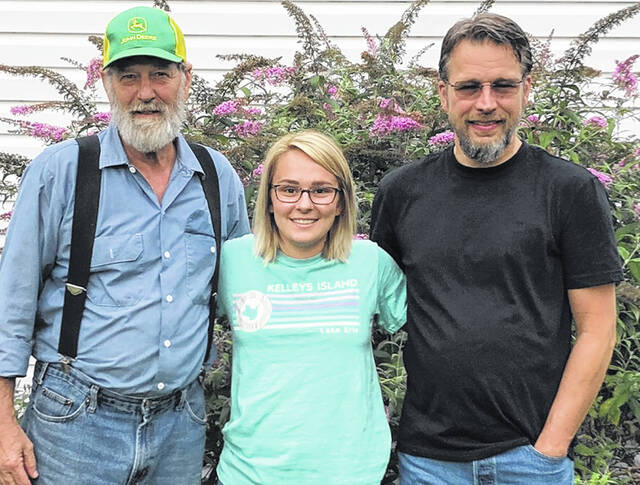



After more than 50 years, a Sabina man has discovered his birth father and found close relatives living just 20 miles from his hometown — as well as a host of cousins in cities across the United States, some more than 2,000 miles away.
He made the discovery through a combination of DNA testing, genetic genealogy science, and old-school detective work over a two-month period in late spring of 2021.
Moreover, the man has traced his family roots to pre-Revolutionary America, Scotland and England dating back to the early 1700s, and has added nearly 1,000 new relatives to his family tree.
“This is one of the happiest moments of my life,” said Rusty Groves, a native of Clinton County. “To think that we found each other after all this time using technology is a miracle; I’m still in awe.”
Groves, who grew up mistakenly being told that another man was his alleged father, gave saliva samples to the world’s leading DNA testing companies, 23andMe and Ancestry.com, after searching for more than eight years for his birth father on his own.
When the first test results came back from 23andMe in May, he had over 1,500 predicted DNA matches. They included more than a dozen first- and second-cousins, most with names he’d never heard of before.
A new search begins
Overwhelmed by the discovery, he sought help from the research team of CeCe Moore, a nationally respected, genetic genealogy investigator.
Moore’s unique research skills and methods are featured in ABC’s documentary series, “The Genetic Detective.” In the series, Moore helps law enforcement across the United States crack some of the most violent cold cases using genetic genealogy research which she pioneered. Moore also co-founded the Institute for Genetic Genealogy and has contributed to the PBS Television documentary series “Finding Your Roots,” with Henry Louis Gates Jr.
Within 24 hours after Groves reached out to Moore’s team, a veteran researcher — with a record of solving hundreds of similar genealogy mysteries — was put on his case.
“That’s when the search sharpened,” Groves said. “I was so far down in the huge tree branches looking at different generations and names that I lost sight of the big picture — finding the one branch that resulted in my birth.”
Moore’s researcher quickly created a new family tree using Groves’ first findings and a “citizen scientist” approach, relying on Groves’ DNA matches from the test results. She placed each match in his family tree based on the length of DNA they shared with him. The longer the shared lengths of chromosomes, measured in centimorgans, the closer the predicted relationships.
“We kept landing on the same family surnames for each cousin match that she positioned into the family tree,” Groves explained. “They were 100 percent correct at the cousin levels. Within a couple of days, we were getting more confident about the matches and who it was leading to as my possible dad.”
When the second DNA test result came back from Ancestry.com two weeks later, it confirmed matches from the first test and added more people to the mix, including a half-sibling, a paternal aunt, and a paternal granduncle.
“The DNA tests were like flipping a switch and light bulbs coming on … one discovery led to another, which led to another, which ended within 20 miles of my home.”
First impressions
With emotional support from Moore’s researcher, Groves anxiously reached out to his new family by email with the DNA results, unsure of how they would react. Two siblings and their mom agreed to meet with him and his daughter, Elizabeth Massie, at the local library — ironically, in the genealogy room.
On the Saturday before Father’s Day, during an emotional four-hour union amidst tears, he learned that they never knew of his birth or his long search for his dad. However, the siblings had often joked that they might have another sibling somewhere, and their mom said she had been waiting for such a phone call for more than 50 years. The family was most struck by the physical similarities and mannerisms among them.
“We definitely had a lot in common right off the bat, my daughter and I couldn’t have asked for a better meeting,” Groves said. “They welcomed us with open arms and lots of love, which says a lot about their character given the very unusual circumstances.”
Over those first few weeks, he and his daughter met a total of three sisters: Mandy (O’Bryant) Thornton, Michelle (O’Bryant) Elzey and Melissa (O’Bryant) McNabb; a brother, Mike O’Bryant; and mom, Marcia O’Bryant.
Dad and son’s first meeting
On July 29, when Groves was supposed to meet his dad, he started having second thoughts as he made the drive alone to the family’s Jamestown home.
“The closer I got to their house, the slower I started driving and questioning if I really wanted to do this,” Groves recalled of that sunny Thursday afternoon. “At one point, the truck was going 25 mph on a 55 mph rural stretch of road. I started getting looks from drivers behind me.”
But Groves overcame his anxiety and arrived at Stephen and Marcia O’Bryant’s home on time. When he pulled in the driveway and got out of his truck, his dad came walking across the yard to meet him near the back door.
“You look like my brother, Joey!” Steve said with a grin and a handshake. Groves playfully nudged back, “I tried both him and David [Steve’s youngest brother], but the matches didn’t fit. You’re the last one left to make this work!”
With those few words, a dad and son separated by more than 50 years were soon connected through faith and persistence. During the four-hour visit, Groves saw aspects of his own personality which had been a mystery to him — the nervous energy, the dry humor, and the analytical mind. He also saw flashes of his future self, the man he will likely become one day when he grows older.
“Previews of coming attractions,” Groves said with a chuckle.
Before he left, he and his dad hugged and said words they’d never said to each other.
“Bye, dad.”
“Bye, son.”
Two days later, Groves’ daughter met her grandpa Steve for the first time with more tears and hugs. Altogether, the family has spent nearly 30 hours at different visits getting to know each other since June.
They hope to meet with more close relatives in the days ahead, including: an adopted brother, James Williamson; uncles, Joey and David O’Bryant; aunts, Carol Ritenour and Vicki O’Bryant; and a granduncle, Larry O’Bryant, the last of his generation.
“This couldn’t have happened 30 years ago, or even five years ago,” Groves said. “The chances of finding relatives have improved with more people giving DNA samples. Also, genealogy research techniques used by CeCe Moore’s team really helped with this discovery. I’m so blessed.”
A son denied
Groves’ story has not one, but two parts.
The first part began with a paternity court case in 1978, more than seven years after his birth. Groves never met the man mistakenly named as his alleged father except for one time at a blood testing facility in Dayton when they went for a court-ordered paternity test.
For 42 years, the family was led to believe that the blood test results were inconclusive and that the man was Groves’ father. The man denied it, and Groves was skeptical as well with no proof to back it up. His birth certificate listed no father, the paternity case was closed, and the family had no records of the blood test results.
In the years before and after the case, Groves spent much of his childhood living with his maternal grandparents. He was a genetic paradox — a boy with no dad, but with many father figures along the way: his grandfather, a maternal granduncle, maternal uncles through marriage, church leaders, former bosses, close friends and co-workers.
“I missed out on a lot of father-and-son activities growing up,” Groves recalls, “but there were always people put in my path who helped shape my values. Reading was an important thing for me. It not only gave me a way to escape my circumstances, but it helped me learn about life. I stumbled and made a lot of mistakes but always tried to pick myself up and keep going.”
“Your dad died”
The second part of this story began in September 2013, when Groves was at a Cincinnati Reds baseball game at Great American Ball Park. He got a phone call that his alleged father, who lived in Bucyrus at the time, had passed away after a short illness.
“It was at that point I knew I had to find answers,” Groves said. “I needed closure after looking in the mirror every day and wondering who the other half of me was … who my dad really was.”
Even though the Cincinnati Reds lost to the Pittsburgh Pirates in an 8-3 ballgame on that bright, sunny day, Groves determined not to let it be another loss for him. He was going to find out the truth, finally.
This led him on a years-long, painstaking search for clues about his past. But he had little to go on other than a single-page, 1978 letter from the county juvenile court, which set a hearing date for the paternity case.
Groves contacted the county courthouse looking for any documents that might have survived the passing of time. He was told that records that old didn’t exist, and if they did, they would be extremely difficult to find.
Calls to the local Jobs & Family Services agency and a blood-testing lab believed to have been used by the county in the 1970s also came up empty.
Most public agencies and private testing companies only keep paternity test records for a limited time — in Groves’ case he was told it was seven years.
Answers in the attic
An increasingly hopeless situation turned positive with what he learned next.
“I received a call from the court archives department. They had found the original paternity case and blood test results,” Groves said. “A clerk found them boxed away in the attic. She was flabbergasted they were still there after more than 35 years.”
Groves quickly read the case history and blood test results expecting to see the inconclusive results. To his surprise, the blood test report excluded his alleged father. His mind at once went into a tailspin with questions, trying to reconcile what he had been told growing up with what the court records revealed.
Had the Dayton facility been accredited for relationship testing? What were their quality standards? Could there have been flaws in the testing processes?
Blood test under scrutiny
He decided to get an independent review of the blood test records and reached out to a world-class expert in the field of paternity testing and forensic science. In October 2013, he spoke with Dr. Howard Coleman, the CEO of Washington-based Genelex Corporation, and asked him to review the paternity test results. He learned that while the results were quite old, the test was done according to “state of the art” technology for that time.
“It pretty conclusively excludes the tested man from being your father,” Dr. Coleman told Groves in an email. As far as a testing mix-up causing a false negative result, Dr. Coleman said that such things were “a very rare occurrence.” Out of the tens of thousands of re-test cases — some like Groves’ — that Coleman’s team had been involved with over the years, “only once did we reverse the original test result.”
Shortly after, Groves contacted Patty Malone, a quality and regulatory affairs director, and Dr. James Alexander, a pathologist and medical director, at the Dayton blood testing center. He asked them to review the test results for defects in testing methods used at the time.
In the 1970s, most court systems relied on human leukocyte antigen and red blood cell testing to determine paternity. Medical professionals would draw blood specimens from a child, the presumed mother, and an alleged father. A child inherits a set of A and B blood antigen proteins from each parent. Paternity can be established or ruled out by comparing the blood specimens of a child with those of the presumed mother and alleged father.
“The community blood center was very consistent in their review of the original results,” Groves said. “They confirmed that those results, which excluded my alleged dad, were conclusive and no other interpretation was possible.”
The trail grows cold
In 2014, Groves tracked down one of the Bucyrus man’s brothers, an alleged uncle, who agreed to a DNA swab test. Those results also ruled out a biological connection. During the same time, an old classmate reached out to Groves on Facebook and told him she believed they were half-siblings. The two later did DNA testing together which showed no such relationship.
In desperation, Groves contacted a second man whose name had been floated by some family members as his possible father. In multiple conversations by email and phone, the Oregon man denied any possibility of being his father. He also declined, for privacy reasons, to do DNA testing which left Groves with lingering doubts.
With all leads exhausted, the paternity trail grew cold until early 2021. Groves began researching his maternal family tree and decided to give saliva samples to two of the world’s leading DNA testing companies.
DNA testing works by collecting a person’s saliva or cheek swab sample. The sample gets mixed with a preserving solution, sealed and mailed back to testing companies. The companies analyze it using FDA-approved rigorous quality standards and look for matches with millions of people in their DNA databases.
Since most human DNA is identical from person to person, testing companies look for DNA variations that make people unique. These variants can find predispositions to health conditions, personality traits and ancestry groups.
“Up to this point, I had privately tested with alleged relatives who were known to me, which gave me some control and limited my risk,” Groves said. “This time, it was like throwing my DNA sample into a gene pool of more than 26 million people — about twice the size of Ohio — but with the potential to reach around the world, to see what sticks.”
A Divine presence
When the first test results came back 10 days later, Groves had a whopping 1,500-plus predicted DNA matches.
“Ninety-nine percent of the matches were third-, fourth- and other distant cousins,” Groves said. “I was more interested in the 1 percent of cousins that I shared a stronger DNA link with — the ones I shared a common recent ancestor with.”
He started by looking at first- and second-cousins with the strongest DNA matches and narrowed his list of names down to 18 for more research. He used those results to build a paternal family tree, working backward from each cousin match.
“It was like building your own family tree, only 18 times over,” Groves said. “It took a lot of late nights of reading marriage and death certificates, obituaries, and U.S. Census records.”
Groves said throughout the process, there was a Divine presence guiding him through the data. “He sent me confirming signs along the way,” Groves said, “like coming across similar names and exact birth and death dates of relatives in my maternal family. It was a revelation in the DNA data.”
After the DNA test results came back and CeCe Moore’s research team stepped in, Groves said it was like “the Master Creator’s hand was guiding us through His human genetic code.”
Healing and helping others
Groves also credits a support network of family, trusted friends, and co-workers — including those he’s lost touch with or who have since passed away.
“Everyone who helped and guided me over the years was incredibly special to me. Lots of prayers, and they got answered in a big way,” he said.
Groves, who has a daughter, Elizabeth Massie, and two grandchildren, Reagan and Kaysen, decided to come forward with his story for two reasons: for healing and to help others. He has also started work on a manuscript about his experiences that he hopes to self-publish soon.
“There are millions of people looking for answers,” Groves said. “By nature, I’m a very private person. But if my story can give someone the courage or hope they need to find answers to their story, it’s worth it. Everyone deserves to know who they are, where they came from, and where they’re going.”
Groves is not sure what the future holds, but is thankful for the new, and renewed, relationships with both sides of his family throughout the experience.
“I’d been looking for answers in people and things around me my whole life, which brought a lot of heartache and pain that I had to internalize. The real clues were inside me, inside my DNA. Once I started looking there, I found answers.”
For Groves, his long search for one man ended within 20 miles of his hometown and with nearly 1,000 new relatives added to his family tree in a matter of a few short weeks.
“That’s a testament to the power of technology and human determination.”
After a pause and a laugh, he added, “And I’m still counting.”





